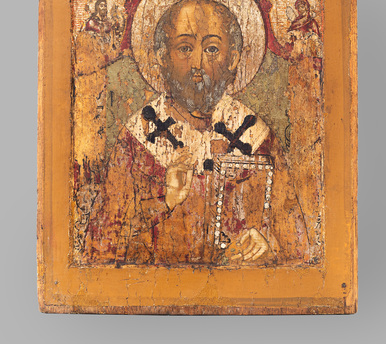The Deesis icon of the Mother of God is one of the icons of Saint Nicholas Church in the village of Kovda, an old Pomor settlement in the south of the Murmansk region, surrounded on three sides by the waters of the Kandalaksha Bay and the river, after which the village was named. The church was built at the beginning of the 18th century and was open almost without any restoration until the middle of the 20th century. The building is a unique monument of Pomor architecture — an example of a rare temple building with a two-tier gable roof. The iconostasis of the church in Kovda was created at the beginning of the 17th century by a master, most likely sent by the Solovetsky Monastery.
In 1964, the temple was closed, and during the research expedition of the Russian Museum many icons were distributed to the museums of the North-West for storage, and after restoration in 1994, some of them entered the collection of the Murmansk Regional Art Museum.
The Deesis (Deesis tier) is a tripartite composition depicting Jesus Christ, John the Baptist and the Mother of God. The Greek word “Deesis” means a “petition” and a “prayer”.
In the Deesis, the saints stand before Christ in supplication on behalf of humanity. The central figure is the image of Christ the Almighty, less often the Savior in Power, then the Mother of God is depicted on the right hand and John the Baptist on the left hand of the Savior. In iconography, the Mother of God from the Deesis tier is depicted without the Child, turning to the right (towards the Savior) in a gesture of prayer.
The Deesis originated in Byzantium as a decorative element of the altar screen. The three-part composition of the Virgin Mary and John the Baptist standing on either side of Jesus Christ was called the Small Deesis. In Russian art, this composition developed into the Great Deesis, which also included icons of the apostles, archangels and saints.
The tradition of North Russian icon painting is distinguished by muted colors and composition. This icon is painted in calm, golden-brown colors; the ocher fields and the background, as well as the thin golden halo make the image especially restrained and rigorous, focusing on the complex drapery and rich patterns that decorate the clothes of the Mother of God — the Queen of Heaven.
In 1964, the temple was closed, and during the research expedition of the Russian Museum many icons were distributed to the museums of the North-West for storage, and after restoration in 1994, some of them entered the collection of the Murmansk Regional Art Museum.
The Deesis (Deesis tier) is a tripartite composition depicting Jesus Christ, John the Baptist and the Mother of God. The Greek word “Deesis” means a “petition” and a “prayer”.
In the Deesis, the saints stand before Christ in supplication on behalf of humanity. The central figure is the image of Christ the Almighty, less often the Savior in Power, then the Mother of God is depicted on the right hand and John the Baptist on the left hand of the Savior. In iconography, the Mother of God from the Deesis tier is depicted without the Child, turning to the right (towards the Savior) in a gesture of prayer.
The Deesis originated in Byzantium as a decorative element of the altar screen. The three-part composition of the Virgin Mary and John the Baptist standing on either side of Jesus Christ was called the Small Deesis. In Russian art, this composition developed into the Great Deesis, which also included icons of the apostles, archangels and saints.
The tradition of North Russian icon painting is distinguished by muted colors and composition. This icon is painted in calm, golden-brown colors; the ocher fields and the background, as well as the thin golden halo make the image especially restrained and rigorous, focusing on the complex drapery and rich patterns that decorate the clothes of the Mother of God — the Queen of Heaven.



